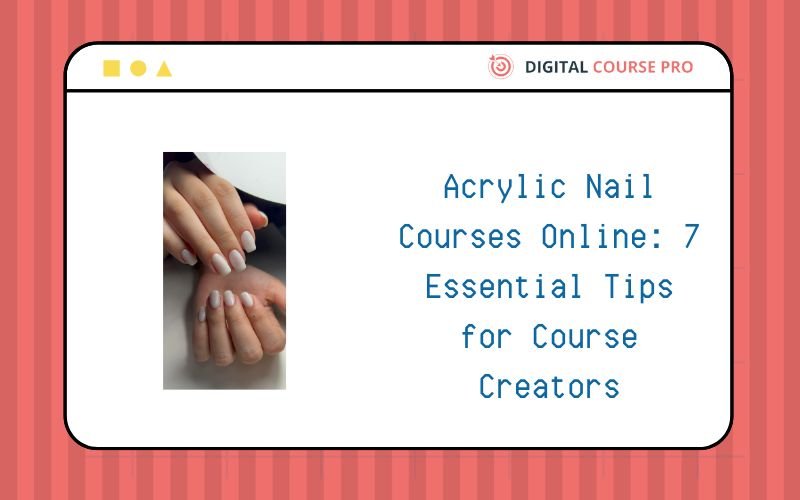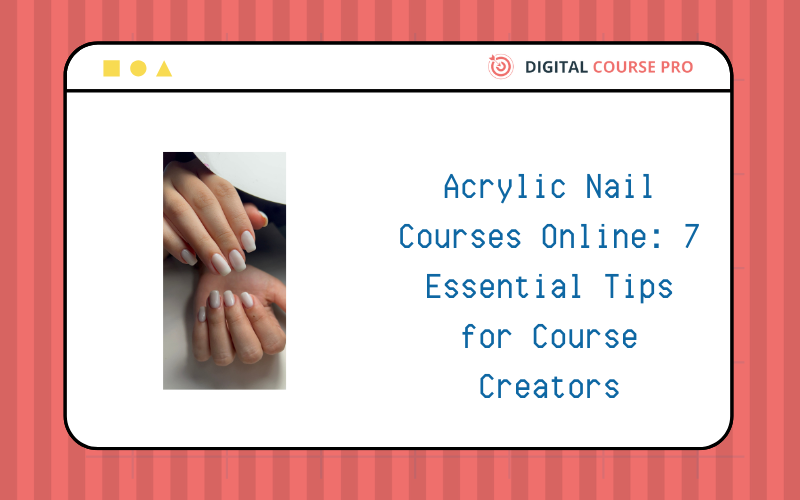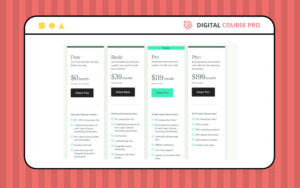Acrylic nail courses online have become increasingly popular, offering aspiring nail technicians the flexibility to learn and master nail art from the comfort of their homes. If you’re a course creator looking to tap into this growing market, it’s crucial to design a program that stands out and meets the needs of your students. Here are seven essential tips to help you create an outstanding online acrylic nail course:

Understand Your Target Audience
Acrylic nail courses online are designed to cater to a diverse range of students, each with unique needs and expectations. To create a successful course, it’s essential to understand your target audience thoroughly. Here’s how to do it:
Identifying Your Ideal Students
Skill Level
- Determine whether your course is aimed at beginners, intermediates, or advanced learners. Beginners will need foundational knowledge and basic techniques, while more experienced students may be looking for advanced skills and specialization.
Demographics
- Consider the age, gender, and location of your potential students. For instance, younger students might be more interested in trendy and creative nail designs, while older students may focus on classic and professional looks.
Professional Goals
- Understand what your students aim to achieve. Are they hobbyists looking to improve their personal skills, or are they aspiring professionals who want to start a career in nail artistry? Tailoring your course content to meet these goals can enhance its relevance and appeal.
Learning Preferences
- Some students prefer visual learning through videos, while others may benefit from written guides and interactive quizzes. Offering a variety of content types can cater to different learning styles and improve student engagement.
Conducting Market Research
Surveys and Questionnaires
- Send out surveys to potential students to gather information about their interests, needs, and preferences. Questions could include their current skill level, specific topics they want to learn, and their preferred learning format.
Competitor Analysis
- Analyze existing acrylic nail courses online to identify gaps in the market. Look at reviews and feedback to understand what students appreciate and what they feel is missing. This can help you create a course that stands out.
Social Media and Online Communities
- Engage with online communities and social media groups focused on nail art and beauty. These platforms are valuable for understanding trends, common questions, and the types of content that resonate with your target audience.
Customizing Your Course Content
Beginner-Focused Content
- For beginners, provide comprehensive introductory modules that cover nail anatomy, basic tools and products, and fundamental techniques. Clear, step-by-step instructions and demonstrations are crucial for this group.
Advanced Techniques for Experienced Students
- If your course targets experienced students, delve into advanced techniques such as intricate designs, 3D nail art, and the use of specialized tools. Include tips and tricks from industry experts to provide added value.
Career-Oriented Modules
- For those aiming to become professional nail technicians, include modules on business skills, client management, and industry standards. Offering insights into setting up a nail salon or working as a freelance artist can be highly beneficial.
By thoroughly understanding your target audience, you can design an acrylic nail course online that meets their needs, keeps them engaged, and helps them achieve their goals. This targeted approach not only enhances the learning experience but also increases the chances of your course’s success in the competitive online market.
Comprehensive Curriculum Design
Creating a comprehensive curriculum for acrylic nail courses online is vital for providing a structured and effective learning experience. A well-designed curriculum ensures that students acquire the necessary skills progressively and confidently. Here’s how to design a robust curriculum for your online acrylic nail course:
Structuring Your Course Content
Foundation Modules
- Start with the basics to ensure all students have a solid understanding of fundamental concepts. This can include:
- Nail Anatomy and Health: Cover the structure of the nail, common nail conditions, and proper nail care.
- Tools and Materials: Introduce the essential tools and products used in acrylic nail application, such as brushes, files, and acrylic powders.
Intermediate Techniques
- Once the basics are covered, move on to intermediate techniques:
- Acrylic Application: Teach the step-by-step process of applying acrylic nails, including preparation, application, and finishing.
- Filing and Shaping: Show various nail shapes (e.g., almond, stiletto, coffin) and how to achieve them.
- Basic Nail Art: Introduce simple nail art designs that students can practice.
Advanced Techniques
- For students who have mastered the basics and intermediate techniques, offer advanced modules:
- Intricate Nail Art: Cover complex designs such as marble, ombre, and geometric patterns.
- 3D Nail Art: Teach how to create three-dimensional nail decorations using acrylic.
- Sculpting and Extensions: Show how to create nail extensions and sculpting techniques for more creative designs.
Including Practical Demonstrations
Step-by-Step Video Tutorials
- Include high-quality video tutorials that demonstrate each technique in detail. Use close-up shots and different angles to ensure students can see exactly what you are doing.
- Break down each step and explain the rationale behind it, making it easier for students to follow and replicate.
Interactive Practice
- Encourage students to practice what they’ve learned through assignments and projects. Provide feedback on their work to help them improve.
- Incorporate quizzes and interactive activities to reinforce learning and assess comprehension.
Providing Supportive Learning Resources
Written Guides and PDFs
- Supplement video tutorials with written guides and downloadable PDFs that students can refer to offline. Include detailed instructions, diagrams, and tips for troubleshooting common issues.
Resource Lists
- Provide lists of recommended tools, products, and suppliers. This helps students gather the necessary materials to practice their skills effectively.
Assessing Student Progress
Regular Assessments
- Include quizzes and assessments at the end of each module to evaluate student understanding and retention. Use a mix of multiple-choice questions, short answers, and practical assignments.
Final Project
- Have students complete a final project that incorporates all the skills they’ve learned. This could be a comprehensive nail design or a full set of acrylic nails that demonstrates their proficiency.
Certification
- Offer a certificate of completion to students who successfully finish the course. This adds value and can enhance their professional credibility.
Continuous Improvement
Student Feedback
- Regularly collect feedback from students to understand what’s working and what can be improved. Use this feedback to update and refine your course content.
Staying Updated
- Keep your curriculum current by staying updated with the latest trends and techniques in the nail industry. Incorporate new methods and styles to keep your course relevant and engaging.
By designing a comprehensive curriculum for your acrylic nail courses online, you ensure that your students receive a thorough and well-rounded education. This not only helps them master the art of acrylic nails but also sets them up for success in their nail artistry careers.
Engaging and High-Quality Content
Creating engaging and high-quality content for your acrylic nail courses online is essential for maintaining student interest and ensuring effective learning. High-quality content not only enhances the learning experience but also sets your course apart from others in a competitive market. Here are key strategies to develop engaging and high-quality content for your online acrylic nail course:
Diverse Content Formats
Video Tutorials
- High-quality video tutorials are a cornerstone of any online course. Use HD cameras and professional lighting to ensure clear and detailed visuals.
- Break down complex techniques into step-by-step instructions. Include close-up shots and different angles to show the finer details of nail art and acrylic application.
Written Guides and PDFs
- Complement video content with written guides and downloadable PDFs. These should include detailed instructions, diagrams, and tips for troubleshooting common issues.
- Written content provides students with resources they can refer to offline, reinforcing their learning.
Interactive Quizzes
- Incorporate quizzes and interactive elements at the end of each module to assess student understanding and retention. Use a mix of multiple-choice questions, short answers, and practical exercises.
Live Sessions
- Offer live Q&A sessions or webinars where students can interact with you directly. This provides an opportunity for real-time feedback and personalized guidance.
Visual and Audio Quality
Professional Production
- Invest in good-quality equipment for recording your videos. Clear audio and sharp visuals are crucial for demonstrating intricate techniques in acrylic nail art.
- Edit your videos to ensure smooth transitions, add text overlays for important points, and include background music if appropriate, ensuring it doesn’t distract from the content.
Consistent Branding
- Maintain a consistent visual style throughout your course. Use branded slides, colors, and fonts to create a cohesive and professional look.
Engagement Techniques
Interactive Elements
- Use interactive elements such as polls, quizzes, and discussion boards to keep students engaged. Interactive content encourages active participation and helps reinforce learning.
Gamification
- Incorporate gamification techniques like badges, points, and leaderboards to motivate students. This can make learning more enjoyable and rewarding.
Student Projects
- Assign practical projects where students can apply what they’ve learned. Provide clear instructions and criteria for these projects, and offer constructive feedback on their work.
Supportive Community
Online Community
- Create an online community or forum where students can interact, share their work, ask questions, and support each other. A sense of community can significantly enhance the learning experience.
- Participate actively in the community by answering questions and providing additional tips and resources.
Mentorship and Feedback
- Offer opportunities for one-on-one mentorship or personalized feedback sessions. This can help students overcome specific challenges and improve their skills more effectively.
Continuous Improvement
Regular Updates
- Keep your content up-to-date with the latest trends and techniques in acrylic nail art. Regularly update your videos, guides, and quizzes to ensure they remain relevant and valuable.
Student Feedback
- Collect and analyze student feedback to identify areas for improvement. Use this feedback to refine your content and make it more engaging and effective.
Analytics and Insights
- Use analytics tools to track student progress and engagement. Identify patterns and areas where students may be struggling, and adjust your content accordingly to address these challenges.
By focusing on creating engaging and high-quality content for your acrylic nail courses online, you can provide a superior learning experience that keeps students motivated and helps them achieve their goals. High-quality content not only enhances student satisfaction but also boosts the reputation and success of your online course.
Practical Demonstrations
Providing practical demonstrations in your acrylic nail courses online is crucial for helping students grasp techniques and apply what they learn. Practical demonstrations bridge the gap between theoretical knowledge and hands-on practice, enabling students to see exactly how techniques are performed in real-time. Here’s how to effectively incorporate practical demonstrations into your online acrylic nail course:
Step-by-Step Video Tutorials
Detailed Breakdown
- Create video tutorials that break down each technique into manageable steps. Start with an overview of the process, then dive into each step with detailed explanations and demonstrations.
- Use clear, concise language to explain what you’re doing and why. This helps students understand the rationale behind each step.
Close-Up Shots
- Use close-up shots to capture intricate details. High-resolution close-ups allow students to see the finer points of techniques, such as brush strokes, the application of acrylic, and filing angles.
- Employ multiple camera angles to provide different perspectives. This can help students grasp complex techniques more effectively.
Real-Time Demonstrations
- Perform demonstrations in real-time, allowing students to follow along at their own pace. Real-time demonstrations provide a realistic view of how long each step takes and the level of precision required.
- Include commentary throughout the demonstration to highlight important points and common pitfalls.
Interactive Practice Sessions
Guided Practice
- After demonstrating a technique, provide guided practice sessions where students can follow along. Pause periodically to allow students to practice each step before moving on to the next.
- Offer tips and reminders during these pauses to reinforce key concepts and ensure students stay on track.
Assignments and Projects
- Assign practical projects that require students to apply the techniques they’ve learned. For example, have them create a specific nail design or complete a full set of acrylic nails.
- Provide clear guidelines and criteria for these assignments, and encourage students to submit their work for feedback.
Feedback and Assessment
Peer Review
- Encourage students to share their work in a course community or forum. Implement a peer review system where students can provide constructive feedback to each other.
- Peer review fosters a collaborative learning environment and allows students to learn from one another’s experiences.
Instructor Feedback
- Offer personalized feedback on students’ work. This can be done through written comments, recorded video feedback, or live feedback sessions.
- Highlight strengths and areas for improvement, providing specific suggestions on how to enhance their technique.
Supplementary Resources
Reference Materials
- Provide supplementary materials such as written guides, diagrams, and checklists that students can refer to while practicing. These resources can help reinforce the techniques demonstrated in your videos.
- Include troubleshooting guides to address common issues students might encounter during practice.
Practice Kits
- Offer or recommend practice kits that include the necessary tools and materials for students to use. This ensures they have everything they need to practice effectively at home.
- Provide detailed instructions on how to use each item in the kit, linking back to your video demonstrations.
Live Demonstrations
Webinars and Live Sessions
- Host live webinars or Q&A sessions where you can demonstrate techniques in real-time and answer students’ questions on the spot.
- Live sessions offer an interactive experience, allowing students to seek clarification and engage directly with you.
Recorded Live Sessions
- Record these live sessions and make them available for students who couldn’t attend. This ensures that all students have access to the same valuable content.
- Include timestamps or chapters in the recordings to help students easily navigate to specific parts of the demonstration.
By incorporating practical demonstrations into your acrylic nail courses online, you provide students with the hands-on experience they need to master the art of acrylic nails. Practical demonstrations not only enhance understanding but also build confidence, empowering students to apply their skills professionally.
Student Support and Interaction
Effective student support and interaction are key elements in the success of acrylic nail courses online. Providing robust support and fostering interactive environments help students stay engaged, motivated, and confident in their learning journey. Here’s how to enhance student support and interaction in your online acrylic nail course:
Creating a Supportive Learning Environment
Accessible Instructor
- Make yourself accessible to students by offering regular office hours, live Q&A sessions, or dedicated times for one-on-one consultations. This gives students the opportunity to ask questions, seek clarification, and get personalized feedback.
- Respond promptly to student inquiries via email, discussion boards, or messaging platforms. Timely responses show that you are committed to their success.
Comprehensive FAQs
- Develop a comprehensive FAQ section that addresses common questions and challenges students might face. This can serve as a quick reference and reduce repetitive queries.
- Update the FAQs regularly based on student feedback and new insights gained from the course.
Interactive Learning Activities
Discussion Boards and Forums
- Create discussion boards or forums where students can interact, share experiences, and support each other. Encourage participation by posting thought-provoking questions and topics.
- Monitor these forums actively to provide guidance, correct misconceptions, and foster a positive and inclusive community.
Group Projects and Peer Reviews
- Assign group projects to encourage collaboration among students. Working together on projects can enhance learning through shared knowledge and diverse perspectives.
- Implement a peer review system where students provide constructive feedback on each other’s work. Peer reviews help students learn to critique constructively and improve their own skills through observation.
Providing Personalized Feedback
Detailed Feedback on Assignments
- Offer detailed and constructive feedback on student assignments and projects. Highlight strengths and areas for improvement, providing specific suggestions on how to enhance their work.
- Use video or audio feedback to make the feedback more personal and easier to understand.
Progress Tracking and Reports
- Provide students with progress tracking tools and regular reports on their performance. This can include completed modules, quiz scores, and overall progress.
- Use this data to identify students who might be struggling and offer additional support or resources to help them catch up.
Encouraging Continuous Interaction
Live Webinars and Q&A Sessions
- Host regular live webinars and Q&A sessions to maintain ongoing interaction with students. These sessions can cover advanced topics, address common challenges, or review recent lessons.
- Record these sessions and make them available for students who cannot attend live. This ensures that all students have access to the same valuable content.
Social Media Groups
- Create private social media groups (e.g., on Facebook or Instagram) for your students. These groups can serve as an informal space for students to connect, share their work, and support each other.
- Actively participate in these groups by posting updates, sharing tips, and celebrating student achievements.
Offering Additional Resources
Resource Library
- Develop a resource library with supplementary materials such as articles, videos, templates, and product recommendations. This can provide students with additional learning opportunities and enhance their understanding of the content.
- Update the resource library regularly to include the latest trends, techniques, and industry developments.
Guest Experts
- Invite guest experts from the nail industry to give talks, demonstrations, or Q&A sessions. Exposure to different perspectives and expertise can enrich the learning experience and inspire students.
- Record these sessions and add them to your course content for future reference.
Continuous Improvement
Feedback Surveys
- Regularly collect feedback from students through surveys or feedback forms. Ask about their learning experience, the effectiveness of the support provided, and areas for improvement.
- Use this feedback to make continuous improvements to your course content, support mechanisms, and interaction strategies.
Adapting to Student Needs
- Stay flexible and adapt your support and interaction strategies based on student needs and feedback. Be open to trying new approaches and tools to enhance the learning experience.
- Keep up with the latest e-learning trends and technologies to continuously improve your course delivery and student engagement.
By focusing on student support and interaction in your acrylic nail courses online, you create a nurturing and engaging learning environment. This not only helps students stay motivated and succeed in their learning journey but also builds a strong sense of community and loyalty among your students.
Certification and Accreditation
Offering certification and accreditation in your acrylic nail courses online adds significant value and credibility to your program. It reassures potential students that they will receive recognized credentials upon completion, which can enhance their professional prospects. Here’s how to effectively integrate certification and accreditation into your online acrylic nail course:
Importance of Certification and Accreditation
Credibility and Trust
- Providing a certificate of completion boosts the credibility of your course. It shows that your course meets certain standards and that you are committed to delivering quality education.
- Accredited courses are often more trusted by students and employers. Accreditation from a recognized body adds an extra layer of legitimacy and assurance.
Professional Advancement
- Certification can help students advance their careers by providing formal recognition of their skills and knowledge. This is particularly important for those looking to enter the professional nail industry or enhance their existing qualifications.
- Accredited courses are often preferred by employers, as they indicate that the training meets industry standards.
Designing Your Certification Program
Course Completion Certificate
- Offer a certificate of completion to students who successfully finish your course. Ensure the certificate includes important details such as the course name, your institution’s name, the student’s name, and the date of completion.
- Design the certificate to be visually appealing and professional. Include signatures and seals to add authenticity.
Skill-Based Certification
- Consider offering skill-based certifications for specific techniques or advanced modules. This allows students to earn recognition for particular areas of expertise within the broader field of acrylic nails.
- Develop assessments or practical exams that students must pass to earn these certifications. Ensure these assessments accurately evaluate the skills being certified.
Seeking Accreditation
Identify Relevant Accrediting Bodies
- Research and identify reputable accrediting bodies within the nail and beauty industry. Examples might include national or international beauty associations, vocational training accreditation organizations, or industry-specific certification boards.
- Choose accrediting bodies that are well-recognized and respected by professionals and employers in the nail industry.
Meeting Accreditation Requirements
- Understand the criteria and standards set by the accrediting bodies. This often includes curriculum quality, instructor qualifications, student support, and assessment methods.
- Align your course content and delivery methods to meet these standards. This might involve enhancing your curriculum, improving assessment procedures, or upgrading your instructional materials.
Application Process
- Prepare and submit a comprehensive application to the accrediting body. This typically includes detailed information about your course structure, content, instructional methods, and evaluation processes.
- Be prepared for a review process that might include site visits, interviews, or additional documentation. Demonstrate your commitment to maintaining high standards and continuous improvement.
Promoting Your Certification and Accreditation
Highlighting Accreditation
- Promote your accreditation status prominently on your course website, marketing materials, and social media channels. Highlight the benefits of enrolling in an accredited course, such as industry recognition and enhanced career prospects.
- Include testimonials or endorsements from industry professionals or accrediting bodies to build trust and credibility.
Marketing Certified Courses
- Emphasize the value of your certification in your marketing campaigns. Use phrases like “industry-recognized certification” and “accredited training program” to attract potential students.
- Offer insights into the career opportunities and benefits that come with earning certification from your course.
Continuous Improvement and Reaccreditation
- Maintain high standards in your course content and delivery to ensure continued accreditation. Stay updated with industry trends and adjust your curriculum as needed to meet evolving standards.
- Plan for reaccreditation processes by staying informed about accrediting bodies’ requirements and timelines. Regularly review and enhance your course to ensure it remains relevant and high-quality.
By incorporating certification and accreditation into your acrylic nail courses online, you can significantly enhance the value and appeal of your program. Certification provides students with tangible proof of their skills and knowledge, while accreditation ensures your course meets industry standards. This combination not only attracts more students but also supports their professional growth and success in the nail industry.
Marketing and Promotion
Effective marketing and promotion strategies are essential for attracting students to your acrylic nail courses online. To stand out in a competitive market, you need to leverage various marketing channels and techniques to reach your target audience and highlight the unique value of your course. Here are some key strategies to successfully market and promote your online acrylic nail course:
Understanding Your Target Audience
Identify Your Ideal Students
- Determine who your ideal students are. Are they beginners looking to learn new skills, or experienced professionals seeking advanced techniques? Understanding your audience helps tailor your marketing messages effectively.
- Consider demographics such as age, gender, location, and interests. This information can guide your marketing efforts and help you reach the right people.
Create Buyer Personas
- Develop detailed buyer personas representing your ideal students. Include information about their goals, challenges, and preferences.
- Use these personas to craft targeted marketing messages that resonate with your audience and address their specific needs and pain points.
Utilizing Digital Marketing Channels
Social Media Marketing
- Leverage social media platforms like Instagram, Facebook, TikTok, and Pinterest to showcase your course. Post engaging content such as nail art tutorials, student testimonials, and behind-the-scenes glimpses of your course creation process.
- Use hashtags related to acrylic nails and online learning to increase visibility. Engage with your audience by responding to comments, answering questions, and participating in relevant groups or communities.
Email Marketing
- Build an email list by offering a free resource, such as an eBook or mini-course, in exchange for email addresses. Use this list to send regular updates, promotional offers, and valuable content related to acrylic nails and nail art.
- Create an email marketing campaign that highlights the benefits of your course, shares success stories, and includes a clear call-to-action to enroll.
Content Marketing
- Start a blog on your website where you share informative articles, tutorials, and tips related to acrylic nails and nail art. Optimize your blog posts for SEO to attract organic traffic.
- Create video content for YouTube that provides value to your audience and promotes your course. Include links to your course in the video descriptions and use compelling thumbnails and titles to attract viewers.
Paid Advertising
- Invest in paid advertising campaigns on platforms like Facebook, Instagram, Google Ads, and YouTube. Target your ads based on demographics, interests, and behaviors to reach potential students.
- Use eye-catching visuals and persuasive ad copy that highlights the unique selling points of your course, such as industry accreditation, hands-on practice, and expert instruction.
Building a Strong Online Presence
Professional Website
- Develop a professional website that serves as the hub for your acrylic nail courses online. Ensure it is user-friendly, visually appealing, and optimized for search engines.
- Include detailed information about your course, instructor credentials, student testimonials, and an easy-to-use enrollment process.
SEO Optimization
- Optimize your website and content for search engines by using relevant keywords, such as “acrylic nail courses online,” in your titles, headings, and meta descriptions.
- Create high-quality, informative content that attracts backlinks and improves your site’s authority and ranking in search results.
Online Reviews and Testimonials
- Encourage satisfied students to leave reviews and testimonials on your website, social media pages, and third-party review sites. Positive reviews build credibility and trust with potential students.
- Feature these testimonials prominently in your marketing materials to showcase the success and satisfaction of your past students.
Collaborating and Networking
Influencer Partnerships
- Partner with beauty influencers, nail artists, and industry professionals to promote your course. Influencers can help you reach a broader audience and add credibility to your course.
- Provide influencers with free access to your course in exchange for honest reviews, shout-outs, or collaborative content.
Guest Blogging and Podcasting
- Write guest posts for popular beauty and nail art blogs, or appear as a guest on podcasts related to beauty and online learning. This helps you reach new audiences and establish yourself as an authority in the field.
- Share insights, tips, and success stories in your guest appearances to provide value and entice listeners or readers to check out your course.
Affiliate Marketing
- Set up an affiliate program where partners can earn a commission for referring students to your course. This incentivizes others to promote your course and expand your reach.
- Provide affiliates with marketing materials, such as banners, links, and discount codes, to make it easy for them to promote your course.
How Course Creation Platforms Can Help
Using dedicated course creation platforms can significantly streamline the process of developing and managing acrylic nail courses online. Platforms like Teachable, Thinkific, and Kajabi offer a range of tools and features designed to help course creators build professional and engaging online courses. These platforms provide user-friendly interfaces for creating and organizing course content, integrating multimedia elements, and managing student enrollments and payments. Additionally, they offer marketing and analytics tools to help you reach a wider audience and track your course’s performance. To learn more about the top course creation platforms and how they compare, check out my detailed post on Teachable vs Thinkific vs Kajabi: 3 Top Platforms for Online Courses.
By implementing these marketing and promotion strategies, you can effectively attract students to your acrylic nail courses online. A well-executed marketing plan not only increases enrollment but also builds a strong brand presence and reputation in the beauty education industry.
By focusing on these key areas, you can create a comprehensive and engaging acrylic nail course that not only educates but also inspires your students to excel in their nail artistry careers.





